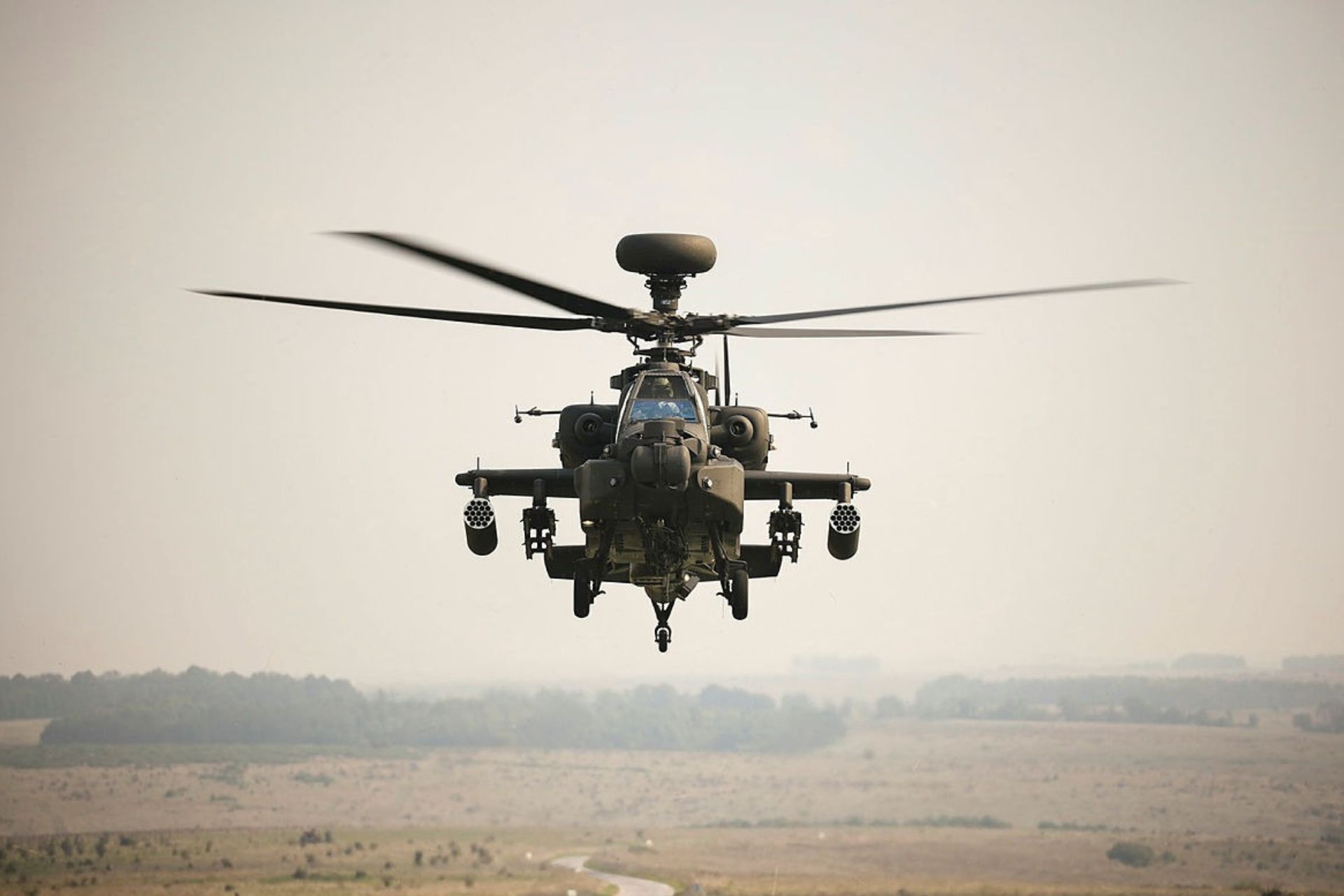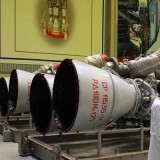New AH-64E Apache Helicopters Strengthen Reconnaissance and Fire Support for British Forces

{loadposition bannertop}
{loadposition sidebarpub}
The UK Ministry of Defence has announced the arrival of three additional Boeing AH-64E Apache attack helicopters, transported by air to the country. This latest delivery increases the number of AH-64Es in service with the Army Air Corps to 47, with three more units expected to complete the total order of 50 helicopters. The modernization program aims to gradually replace the Apache Mk 1, a modified version of the AH-64D that has been in service with British forces for several decades.
Follow Army Recognition on Google News at this link
The progressive integration of the AH-64E into UK forces represents a key step in modernizing the Army Air Corps’ attack aviation capabilities (Picture source: UK MoD)
The AH-64E introduces significant technological enhancements compared to its predecessor, improving operational effectiveness and survivability in combat. Designed for a wide range of missions, the aircraft is primarily used for engaging armored units, reconnaissance, target acquisition (ISTAR), escort, and force protection. It can operate in complex environments, day and night, and in all weather conditions, supported by an advanced sensor suite and the Longbow radar mounted above the main rotor. This radar can detect, classify, and prioritize up to 256 targets simultaneously, displaying the 128 most relevant to the crew and identifying the top 16 threats within seconds.The AH-64E’s weapons system provides high firepower and operational flexibility. It is equipped with an M230 30mm automatic cannon with a firing rate of 600 to 650 rounds per minute, along with a payload that includes up to 76 70mm rockets and 16 Hellfire air-to-ground missiles capable of engaging armored vehicles and fortified positions at long range. Its optical and thermal sensors enable precise target identification and navigation in low-visibility conditions. An integrated electronic warfare suite enhances survivability against aerial and ground-based threats, allowing the aircraft to operate in high-threat environments with advanced anti-access/area denial (A2/AD) systems.The progressive integration of the AH-64E into UK forces represents a key step in modernizing the Army Air Corps’ attack aviation capabilities. Initiated in 2016, the program aligns with evolving air-land combat requirements and interoperability with allied forces, particularly the United States and NATO. With a modular architecture and multi-domain operational capability, the AH-64E is designed to adapt to emerging threats. External fuel tanks can significantly extend their operational range, ensuring sustained presence in operational areas.Boeing manufactures the AH-64E, which benefits from a global supply chain. This includes fuselage production in India by Tata Advanced Systems as part of an industrial partnership. This international production framework helps optimize delivery schedules and reduce costs while maintaining high-quality standards. The UK currently remains the leading European operator of the AH-64E, a position it will hold until Poland begins fielding its order of 96 helicopters.The UK began receiving the AH-64E in November 2020, with the first regiment achieving initial operational capability in October 2023. Originally planned for completion in 2024, logistical constraints have delayed the full delivery of 50 helicopters, pushing the timeline by an additional year. Once all aircraft are delivered, the Army Air Corps will have a fully modernized fleet better suited to contemporary operational demands and expeditionary missions.Meanwhile, the AH-64E continues to expand its global presence. Morocco is set to receive its first batch of six units, with an official handover expected in early March. This growing international interest reflects the demand for advanced attack helicopter capabilities. With enhanced performance and integration into evolving combat doctrines, the AH-64E remains a key asset for armed forces conducting demanding operations, ensuring tactical effectiveness in increasingly complex operational environments.

{loadposition bannertop}
{loadposition sidebarpub}
The UK Ministry of Defence has announced the arrival of three additional Boeing AH-64E Apache attack helicopters, transported by air to the country. This latest delivery increases the number of AH-64Es in service with the Army Air Corps to 47, with three more units expected to complete the total order of 50 helicopters. The modernization program aims to gradually replace the Apache Mk 1, a modified version of the AH-64D that has been in service with British forces for several decades.
The progressive integration of the AH-64E into UK forces represents a key step in modernizing the Army Air Corps’ attack aviation capabilities (Picture source: UK MoD)
The AH-64E introduces significant technological enhancements compared to its predecessor, improving operational effectiveness and survivability in combat. Designed for a wide range of missions, the aircraft is primarily used for engaging armored units, reconnaissance, target acquisition (ISTAR), escort, and force protection. It can operate in complex environments, day and night, and in all weather conditions, supported by an advanced sensor suite and the Longbow radar mounted above the main rotor. This radar can detect, classify, and prioritize up to 256 targets simultaneously, displaying the 128 most relevant to the crew and identifying the top 16 threats within seconds.
The AH-64E’s weapons system provides high firepower and operational flexibility. It is equipped with an M230 30mm automatic cannon with a firing rate of 600 to 650 rounds per minute, along with a payload that includes up to 76 70mm rockets and 16 Hellfire air-to-ground missiles capable of engaging armored vehicles and fortified positions at long range. Its optical and thermal sensors enable precise target identification and navigation in low-visibility conditions. An integrated electronic warfare suite enhances survivability against aerial and ground-based threats, allowing the aircraft to operate in high-threat environments with advanced anti-access/area denial (A2/AD) systems.
The progressive integration of the AH-64E into UK forces represents a key step in modernizing the Army Air Corps’ attack aviation capabilities. Initiated in 2016, the program aligns with evolving air-land combat requirements and interoperability with allied forces, particularly the United States and NATO. With a modular architecture and multi-domain operational capability, the AH-64E is designed to adapt to emerging threats. External fuel tanks can significantly extend their operational range, ensuring sustained presence in operational areas.
Boeing manufactures the AH-64E, which benefits from a global supply chain. This includes fuselage production in India by Tata Advanced Systems as part of an industrial partnership. This international production framework helps optimize delivery schedules and reduce costs while maintaining high-quality standards. The UK currently remains the leading European operator of the AH-64E, a position it will hold until Poland begins fielding its order of 96 helicopters.
The UK began receiving the AH-64E in November 2020, with the first regiment achieving initial operational capability in October 2023. Originally planned for completion in 2024, logistical constraints have delayed the full delivery of 50 helicopters, pushing the timeline by an additional year. Once all aircraft are delivered, the Army Air Corps will have a fully modernized fleet better suited to contemporary operational demands and expeditionary missions.
Meanwhile, the AH-64E continues to expand its global presence. Morocco is set to receive its first batch of six units, with an official handover expected in early March. This growing international interest reflects the demand for advanced attack helicopter capabilities. With enhanced performance and integration into evolving combat doctrines, the AH-64E remains a key asset for armed forces conducting demanding operations, ensuring tactical effectiveness in increasingly complex operational environments.




